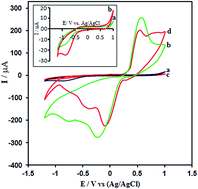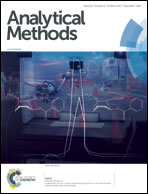Ni–Al/layered double hydroxide/Ag nanoparticle composite modified carbon-paste electrode as a renewable electrode and novel electrochemical sensor for hydrogen peroxide
Abstract
In the present study, a simple and highly sensitive electrochemical method was developed for the determination of hydrogen peroxide (H2O2) through a Ni–Al/layered double hydroxide/Ag nanoparticle composite modified carbon-paste electrode (Ni–Al/LDH/Ag NPs/CPE) as a renewable electrode in 0.1 M phosphate buffer solution (PBS, pH = 7.0). Scanning electron microscopy (SEM), atomic force microscopy (AFM), and X-ray diffraction (XRD) were performed for the characterization of the Ni–Al/LDH/Ag NP composite. The electrocatalytic activity of the Ni–Al/LDH/Ag NPs/CPE for H2O2 reduction was studied by cyclic voltammetry and chronoamperometric (at an applied potential of −0.9 V) methods. The prepared renewable modified electrode as a H2O2 sensor shows good electrocatalytic activity, fast response time, good stability and reproducibility. The present sensor also displays a linear range from 10 μM to 10 mM concentration of H2O2 with a detection limit of 6 μM (S/N = 3) and sensitivity of 1.863 μA mM−1 cm−2. This sensor was employed successfully for the determination of H2O2 in real samples by the chronoamperometric method, which indicates its applicability in practical analysis.



 Please wait while we load your content...
Please wait while we load your content...